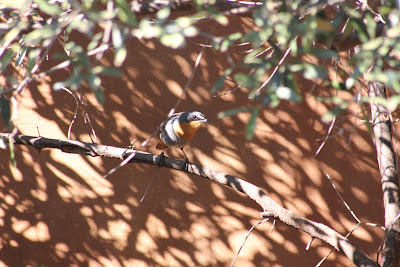Trees are beautiful in their peace, they are wise in their silence. They will stand after we are dust. They teach us, and we tend them.
- Galeain ip Altiem MacDunelmor
My Kiepersol (Cussonia paniculata subsp. sinuata) in April 2012, just starting to show signs of winter
Even though most websites say the Kiepersol (Cabbage Tree) is an evergreen tree, that has not been the case with mine here in Tarlton (Gauteng, South Africa). Above is my Kiepersol in April, just before the winter, and below is my Kiepersol last week (Sept 2012) - it was completely bare, looking almost dead, but now sprouting new leaves and heads.
Over the years it has changed from a single head to four or five, each consecutive winter frost taking its toll. Below you can see a new head forming on an old branch.
New head and leaves
Here it is also forming two new heads on an existing branch - so this one will have three heads.
I planted my 50cm little Kiepersol in 2006 and within a year it had doubled in size. Two years later, in 2009, it had doubled in size again, growing to an impressive 3m within three years.
My Kiepersol in December 2007
My Kiepersol in 2009
My Kiepersol in Feb. 2010
At the beginning of 2010 it still had only one head and was almost 4m tall, beautifully thick and lush.
My Kiepersol in summer - November 2011
During the winter of 2011 it was severely frosted down and in spring sported three new heads, to my utter dismay! My beautiful Kiepersol now seemed destined to take on a completely new look!
My Kiepersol at the end of Sept. 2012 - almost thought I'd lost it but now sporting brand new spring leaves.
To date I've had a lovely trouble-free relationship with my Kiepersol. The only problem I've ever had was two years ago when ALL the leaves were sticky - extremely sticky! I gave the whole tree a thorough once-over, thinking it might be a kind of fly laying its eggs on the leaves, but apart from the stickiness there was absolutely no sign whatsover of any insects, no discoloration, no holes, nothing that I could see. And a Google search has also not revealed anything useful.
Mountain Cabbage tree - Cussonia paniculata subsp. paniculata
There are two subspecies of Cussonia paniculata. The smaller Mountain Cabbage tree C. paniculata subsp. paniculata has leaflets without lobes and has a limited distribution in Eastern Cape (see pic above) and rarely exceeds a height of 3m. C. paniculata subsp. sinuata forms a larger tree with deeply lobed leaves and is more widespread. This is the form more commonly found in cultivation and the one I have in my garden. They can grow up to 15-20 ft. (4.7-6 m).
Cussonias belong to a large family Araliaceae, which include Ginseng, Ivy, and several indoor plants. It is also closely related to the parsley family (Apiacae) which includes several popular vegetables and herbs such as carrots, fennel and parsley.
::
































